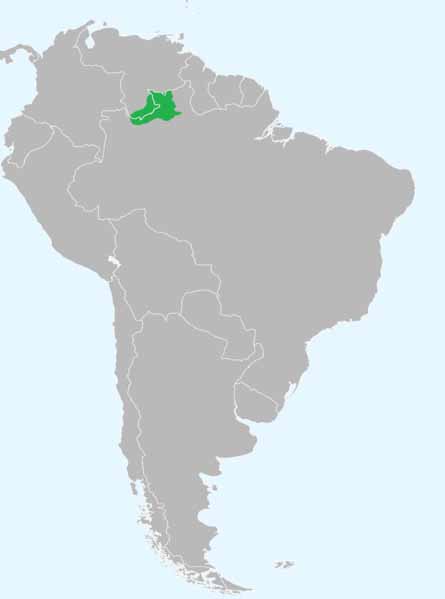

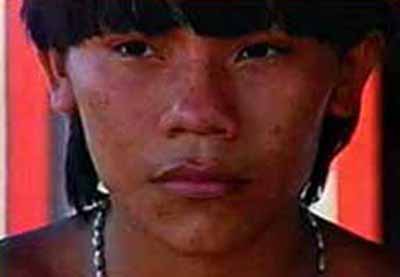




Rare Photos of Brazilian Tribe Spur Pleas to Protect It National Geographic - November 22, 2016
Spectacular new images of an uncontacted indigenous village in Brazil are stirring pleas from tribal leaders and rights advocates for government intervention to protect the settlement from illegal gold prospectors. The aerial photographs show villagers gathered in the center of a traditional, circular structure inside the Yanomami Indigenous Territory, a sprawling reserve of rivers and upland forest situated astride the border with Venezuela.
The Yanomami are an indigenous tribe (also called Yanamamo, Yanomam, and Sanuma) made up of four subdivisions of Indians which live in the tropical rain forest of Southern Venezuela and Northern Brazil. Each subdivision has its own language. They include the Sanema which live in the Northern Sector, the Ninam which live in the southeastern sector, the Yanomam which live in the southeastern part and the Yanomamo which live in the southwestern part of Yanomami area.
The Yanomami depend on the rain forest; they use "slash-and-burn" horticulture, grow bananas, gather fruit, and hunt animals and fish. Yanomami frequently move to avoid areas that become overused, a practice known as shifting cultivation when the soil becomes exhausted.
The Yanomami are known as hunters, fishers, and horticulturists. The women cultivate plantains and cassava in gardens as their main crops. Men do the heavy work of clearing areas of forest for the gardens. Another food source for the Yanomami is grubs. The practice of felling palms to facilitate the growth of grubs was the Yanomami's closest approach to cultivation. The traditional Yanomami diet is very low in salt. Their blood pressure is characteristically among the lowest of any demographic group. For this reason, the Yanomami have been the subject of studies seeking to link hypertension to sodium consumption.
Today about 95% of the Yanomami live deep within the Amazon forest as compared to the 5% who live along the major rivers.
Compared to the "forest people," the "river people" are much more sedentary and subsist by fishing and trading goods such as canoes and hooks with other villages.The "forest people" are horticulturists as well as hunters and gathers. They will spend up to two hours of their day "garden farming" which is quite a labor intensive process. Some of the crops grown include sweet potatoes, bananas, sugar cane and tobacco. However as horticulturists the Yanomami do not get sufficient protein from their crops. Therefore the Yanomami will spend as much as 60% of their time trekking.
Men usually make up the hunters and the women the gathers. Men will go on long distant hunts that may last up to a week. The fact that just about all of the Yanomami live deep within the forest has been quite significant for their survival.
Since most outsiders have invaded the Amazon via the large rivers, the Yanomami have been able to live in isolation until very recently. Because of this they have been able to retain their culture and their identity which many Indians of the Amazon have lost.
Trade also is another important aspect of Yanomami life and helps to reduce the chances of warfare between villages. Often one village will have manufactured goods that are badly needed by an other village.
The Yanomami live in hundreds of small villages, grouped by families in one large communal dwelling called a Shabono; this disc-shaped structure with an open-air central plaza is an earthly version of their gods' abode. They hunt and fish over a wide range and tend gardens in harmony with the forest. Villages are autonomous but constantly will interact with each other. The villages, which contain between 40 and 300 individuals, are scattered thinly throughout the Amazon Forest. The distance between villages may vary from a few hours walk to a ten day walk.
The Yanomami live in villages usually consisting of their children and extended families. Village sizes vary, but usually contain between 50 and 400 people. In this largely communal system, the entire village lives under a common roof called the shabono. Shabonos have a characteristic oval shape, with open grounds in the center measuring an average of 100 yards. The shabono shelter constitutes the perimeter of the village, if it has not been fortified with palisades.
Under the roof, divisions exist marked only by support posts, partitioning individual houses and spaces. Shabonos are built from raw materials from the surrounding jungles, such as leaves, vines, plums and tree trunks. They are susceptible to heavy damage from rains, winds, and insect infestation. As a result, villagers build new shabonos every 1 to 2 years.

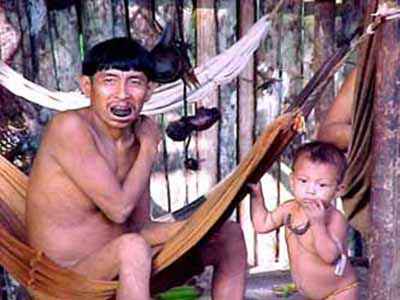
In Yanomami society, marriage ceremonies are almost non-existent and are not celebrated in any way. Polygamous marriages are common, meaning husbands can have many wives. A girl can be promised to a man at an age as young as five or six, however cannot officially be married off until after her first menstrual period.
After a Yanomami girl receives her first menstrual period, she is literally handed off by one of her parents to another man, usually a relative. Cross-cousin marriages, which are marriages between the girl and the son of a maternal uncle or paternal aunt, are the most common form of marriage. Most prefer to marry within that Yanomamo tribe, for fear of violent breakouts between different tribes. The female goes to live with her spouse, and must perform the chores and duties she previously did for her mother.
Violence and abuse between couples in Yanomami culture is very common, and if a woman feels she can no longer bear to live with her husband, she may flee to live with her brothers.
Polygamy is commonly practiced in Yanomami culture, and women are expected to accept this. The elder wife in a marriage usually has precedence over the others, and can act as a boss or a superior over the other wives. She usually no longer has sexual relations with her husband, however she can give the most unpleasant chores to the wife she chooses. The husband is not supposed to show favorites, due to jealousy between the wives.
Cross-cousin marriages among the Yanomami found to benefit grandparents PhysOrg - March 14, 2017
In a multi-year study, researchers describe how they conducted a genealogical study of over 5000 people over the course of 30 years to learn more about Yanomami culture and the impact of cross-cousin marriages. Cross-cousin marriage is where cousins from opposite sex siblings marry, generally as part of an arrangement between the parents of the cousins, who are, of course, siblings. As the researchers note, it is more common than parallel cousin marriages in cultures around the globe, though it is not known why. In South America, a group of indigenous people called the Yanomami live in over 200 villages, which adds up to approximately 35,000 people. Researchers have studied them to learn more about their culture, which includes arranged marriages. The researchers with this effort were interested in cross-cousin or consanguineous marriage, and what benefits it might provide.
Children stay close to their mothers when young; most of the childrearing is done by women. The Yanomami practiced polygyny, though many unions were monogamous. Polygamous families consisted of a large patrifocal family unit based on one man, and smaller matrifocal subfamilies: each woman's family unit, composed of the woman and her children. Life in the village is centered around the small, matrilocal family unit, whereas the larger patrilocal unit has more political importance beyond the village.
The women are responsible for all the domestic duties and chores, excluding hunting and killing game for food. Although the women do not hunt, they do work in the gardens and gather small sources as food. The gardens plots are sectioned off by family, and grow bananas, sugarcane, mangoes, sweet potatoes, papaya, manioc, and other crops. The Yanomami women cultivate these gardens until they are no longer fertile, and then move their plots. Women are expected to carry 70 to 80 pound loads of crops on their backs during harvesting, using bark straps and woven baskets. Plantains and grubs are common sources of food, and are staples in the Yanomami diet.
In the mornings, while the men are off hunting, the women and young children go off in search of termite nests and other grubs, which will later be roasted at the family hearths. Sometimes, the women also pursue frogs, land crabs, or caterpillars, or even look for vines that can be woven into baskets. While some women gather these small sources of food, other women go off and fish for several hours during the day. The women also commonly use plants such as manioc to turn into flat cakes, which they cook over a small pile of coals.
Yanomami women are expected to bear and raise many children, who are expected to help their mothers with domestic chores from a very young age, and mothers rely very much on help from their daughters.
Using small strings of bark and roots, Yanomami women weave and decorate baskets. They use these baskets to carry plants, crops, and food to bring back to the shabono. They use a red berry known as onoto to dye the baskets, as well as to paint their bodies and dye their loin cloths. After the baskets are painted, they are further decorated with masticated charcoal pigment.
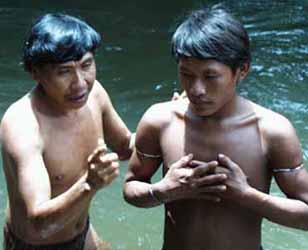
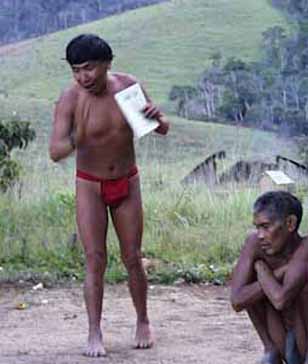
The Yanomami people's traditions are shaped by the belief that the natural and spiritual world are a unified force; nature creates everything, and is sacred. They believe that their fate, and the fate of all people, is inescapably linked to the fate of the environment; with its destruction, humanity is committing suicide. Their spiritual leader is a shaman.
Rituals are a very important part of Yanomami culture. The Yanomami celebrate a good harvest with a big feast to which nearby villages are invited. The Yanomami village members gather huge amounts of food, which helps to maintain good relations with their neighbors. They also decorate their bodies with feathers and flowers. During the feast, the Yanomami eat a lot, and the women dance and sing late into the night.
Although many ceremonies exclude female involvement or participation, they are a large part of the preparation. In preparation for large ceremonies, Yanomami women make alcoholic drinks for the men. The use of hallucinogenic drugs is very common, however women are forbidden from involving themselves in this practice. The women do, however, participate in the practice of endocannibalism. In this practice, the Yanomami people consume the bones of a deceased kinsman. The body is burned, and the bones mixed with food. This tradition is meant to strengthen the Yanomami people and keep the spirit of that individual alive.
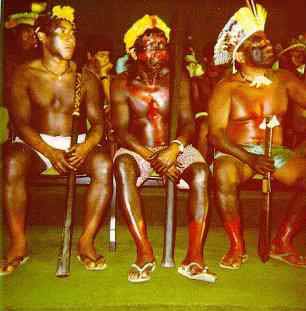

Though many Yanomami are peace, many are fierce warriors. Sometimes their warring is to capture women, so that their best warriors can maximize their reproductive success.
In general, warring villages are usually several days walk from each other, where as tranquil ones may be less than a day. Villages will usually fission when the population reaches 100 to 150 people but in times of warfare villages will not split before they reach a population of around 300 individuals.
Villages may go to war for a number of reasons and warfare makes up a large part of Yanomami life.
About 40% of adult males have killed another person and about 25% of adult males will die from some form of violence. Violence will vary from chest pounding, in which opponents take turns hitting each others on the chest, to club fights, to raids which may involve the killing of individuals and abducting the women, to all out warfare.
The Yanomami had very little contact with the outside world until the 1980's.
Since 1987, the Yanomami have seen about 10% of their entire population - over 2,000 people - decimated by massacres and diseases brought by invaders.
The Yanomamo is the most well known and best documented of the four division partly because they have been victims of a recent gold rush. After gold was discovered on Yanomami land in the mid-1980's, thousands of miners illegally rushed into the territory. The constant flights of supply planes and the noise from generators and pumps used in the mining operation has frightened away the game animals the Indians rely on as a key source of protein in their diet. High pressure hoses are used to wash away river banks, silting the rivers and destroying spawning grounds.
Mercury is used to separate the gold from soil and rock. It is then dumped in the rivers haphazardly. Mercury bio-accumulates and reeks havoc on the entire ecosystem. The effects of mercury poisoning reach even the surrounding trees, some of which rely on birds and fish to disperse their seeds. The mercury ascends the food chain up to the Yanomami in the form of a neurotoxin that especially affects child development. The most devastating statistic of them all: child mortality rates have skyrocketed while birth rates have declined.
The influence of the miners goes well beyond physical health. They introduce alcohol outside of ritual which exacerbates existing rivalries and leads to violence. Weakened by illness and unable to produce and hunt enough food, the Yanomami are reduced to begging and most recently trading sex for food.
For the Yanomami what was once an intricate social system patterned on trading and bartering goods and food amongst themselves has become a game of deadly high stakes where they are trading their culture for their very existence.
The effects are dire. Disoriented by the influx of miners with their unfamiliar culture, technology and diseases, their self-respect has plummeted as their belief and cultural systems are undermined. The Yanomami are not being integrated into Western society; instead begging, prostitution and drunkenness are being introduced into theirs.
In 1992, the Yanomami Territory was demarcated and ratified, yet the government has not consistently kept its commitment to protect their land.
Supported by politicians and business people, the gold miners assault escalated. In July 1993, a group of miners tried to exterminate the village of Haximu, killing 16 Yanomami, in what Brazilian Attorney General Aristides Junqueira classified as genocide. Despite international outcry spurred by the massacre, miners continue to enter the territory illegally.
According to the Commission for the Creation of the Yanomami Park (CCPY) in Sao Paulo and the Indianist Missionary Council (CIMI) in Brasilia, state and local politicians are fighting to reduce the Yanomami territory because they want access to its rich mineral deposits. There is little question that if this happens, the gold prospectors will be replaced by large scale commercial mining operations that will only compound the devastation of the Yanomami and the rainforest.
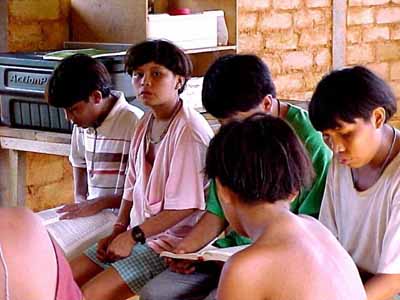
Why Brazil's Yanomami are being decimated by disease, mining PhysOrg - January 27, 2023
Severe malnutrition and disease, particularly malaria, are decimating the Yanomami population in Brazil's Amazon rainforest, and on Jan. 20 the federal government declared a public health emergency. While many in Brazil were left wondering how the calamity could materialize seemingly overnight, it didn't come as a surprise to those familiar with the Yanomami's circumstances, who have issued warnings for several years.
ANCIENT AND LOST CIVILIZATIONS